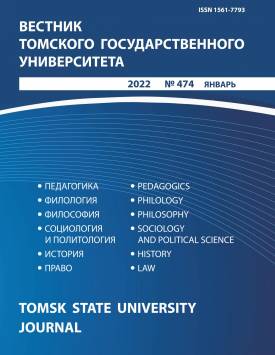Gleb Uspensky's soteriology: From “pig” to “angel”
In modern philological studies, interest in the pathological in Gleb Uspensky's creative personality prevails, namely in the history of his mental illness. The content of the hallucinations of the patient Uspensky is explained exclusively by his suppressed and deformed sexuality. The article offers a different look at Uspensky's creative personality. The aim of the article is to identify the religious and ethical dominant in the creative personality of Uspensky. The research material includes Uspensky's literary texts and documents related to the history of his illness (letters, memoirs of contemporaries, autobiography of the writer). The methodological basis of this study amounted to a combination of methods of biographic, textual, and comparative historical analysis. The article proves that in Uspensky's works, long before his fatal illness, the plot about the struggle of a person with their animal nature was realized. The animal image in Uspensky's essays goes back to penitential canons, in which a sinner, calling to Christ, compares oneself to a “pig lying in feces”. The Christian understanding of sin was complicated by a complex of populist ideas about the social guilt of the privileged classes. Only those heroes of Uspensky who are not engaged in physical labor and do not help people resemble pigs. The article discusses the specificity of the writer's religious views. According to Uspensky, Christ is a hidden God. Invisible and unnamed, he is there with Uspensky's characters in their acts of repentance. Images of the Savior and the resurrection from the dead dominate in Uspensky's late works and form the plot outline of his hallucinations in illness. As a result of the analysis of documentary evidence related to the writer's illness, it is concluded that the experience of spiritual weakness in the struggle with the “pig” was assessed by the sick Uspensky as a path to resurrection, that is, to the restoration of the image and likeness of God in himself. Comparison of Uspensky's letters, as well as the memoirs of his contemporaries, allows concluding that the sick writer perceived himself and those around him as direct participants in the Gospel events - the mystery of the Resurrection. The writer experienced his bodily suffering in the projection of Christ's torment on the cross. Thus, Uspensky's soteriological experience testifies to the unity of his life and creative efforts aimed at fighting sin and gaining holiness.
Keywords
Gleb Uspensky, populism, penitential canon, Boris Sinani, resurrection from the deadAuthors
| Name | Organization | |
| Dyachuk Tatiana V. | Herzen State Pedagogical University of Russia, Saint Petersburg | dia4uk.tanya@yandex.ru |
References

Gleb Uspensky's soteriology: From “pig” to “angel” | Vestnik Tomskogo gosudarstvennogo universiteta – Tomsk State University Journal. 2022. № 474. DOI: 10.17223/15617793/474/8
